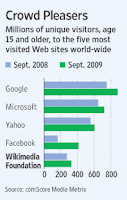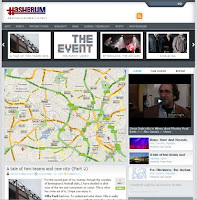WAN-IFRA launches World Newspapers Congress in India
 Today sees the start of the 62nd World Newspaper Congress and 16th World Editors Forum in Hyderabad, India, hosted by WAN-IFRA.
Today sees the start of the 62nd World Newspaper Congress and 16th World Editors Forum in Hyderabad, India, hosted by WAN-IFRA.Interestingly, the overall theme for the conference is 'Newspapers: A Multi-Media, Growth Business', something that may raise eyebrows of those watching their newsrooms struggle with plunging advertising revenues and shrinking circulation for their print products.
Naturally, how to tackle these hurdles is at the forefront of most of the keynote speeches and panel discussions.
Already, according to WAN’s own Shaping the Future of the Newspaper blog, Are Stokstad (Norway), executive vice president at A-Pressen, suggested that e-readers now make it necessary for newspapers to build strategies that combines both the traditional newspaper and the business model for e-reading.
He described how large investments have been made to expand the opportunities for online newpapers. Social networking sites have become a large part of the generation of these new online papers.
"This past year 3,000 print pages originated in social media. Next year we hope to increase this number to 30,000," he told the conference.
Social networking sites create groups of people interested in similar topics and activities. Many online newspapers are targeting their articles towards these groups, increasing online readership.
Meanwhile Martha Stone (USA), director of Shaping the Future of the Newspaper Project (pictured), talked about the opportunities available to newspapers through mobile phone technology.
"Text message advertising has become one of the hottest new ways to advertise," she said.
Stone also explained how mobile phones have become more than a way to just communicate with others.
She described how phones are becoming more advanced and can now be used not only for talking and texting, but also for online searching, television, blogs, advertising, alerts, and much more.
World Digital Media Trends, created by the SFN project, conducts research each year to show the latest revenue and newspaper trends. This year's study was posted in June and predicts the continued growth of digital media.
The Shaping the Future of the Newspaper blog will continue to bring full coverage of the conference, which will include discussions on Google featuring Kees Spaan, President of the Dutch Newspaper Publishers Association and Gavin O’Reilly, CEO of Independent News and Media as well as a presentation on what newspapers need to know for the digital future by Les Hinton, CEO of the Dow Jones newswire.
You can also follow the conference via the following Twitter feeds @NewspaperWorld and @WANindia2009, using the hashtag #WANindia09, or on Facebook at the conference page. There is also a dedicated congress blog.
Labels: Business Models, Entrepreneurial Journalism, Market Research, Social Networking, WAN-IFRA, World Newspapers Congress























